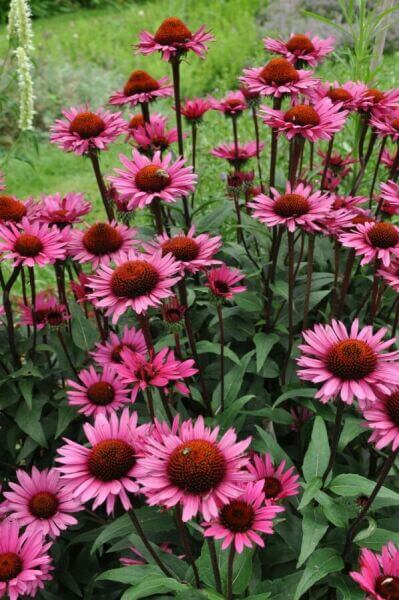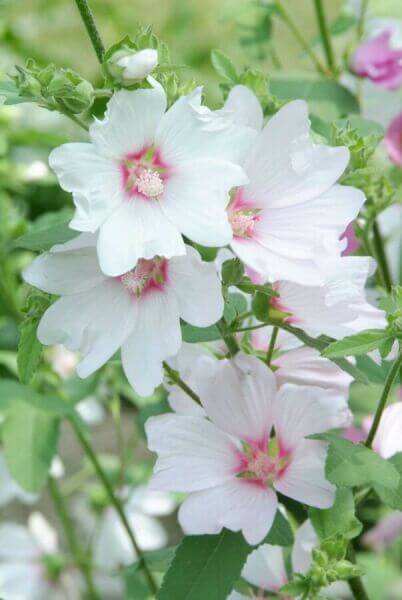Hedging Plants For Wind Protection
Boost your garden's attraction with lavish hedge ranges such as Yew (Taxus), Thuja, Laurel, Photinia, and Bamboo, celebrated for their structural integrity and ecological advantages.
Yew and Thuja provide evergreen protection and winter strength, while Laurel offers fast development and broad, fragrant leaves.
Photinia adds seasonal beauty with its vibrant red foliage, and Bamboo lends a low-maintenance, tranquil ambiance.
These hedges improve air quality, lower noise, and create tranquil, personal areas.
Proper planting, spacing, and maintenance guarantee energetic growth and environmental consistency.
Check out how these lush varieties can raise your garden's charm and wellness.
Key Takeaways
Change Your Garden With Lush Hedge Ranges
- Select Yew for its dense, evergreen growth and exceptional durability.
- Choose Laurel for its fast growth and broad leaves, making sure fast privacy.
- Choose Photinia for its vibrant seasonal foliage, which turns a striking dark red.
- Use Bamboo for a low-maintenance, winter-hardy hedge with aesthetic appeal.
- Space plants 2-3 per meter and prune routinely for optimum development and health.
Popular Hedge Plants
When changing a garden with lavish hedge ranges, it's necessary to think about popular hedge plants such as Yew, Thuja, Laurel, and Photinia due to their unique attributes and benefits.
Yew (Taxus) is highly esteemed for its longevity and dense, green growth, making it a prime choice for enduring landscapes.
Thuja is noted for its evergreen foliage and robust winter resilience.
Photinia adds seasonal vibrancy with red leaves that darken gradually, developing dynamic visual appeal.
Laurel offers rapid growth and aromatic, broad leaves, suitable for fast personal privacy.
Furthermore, Bamboo is an excellent choice for ambiance, offering a low-maintenance, winter-hardy option that boosts the garden's visual with its sophisticated, swaying walking sticks.
These selections cater to a range of horticultural requirements and preferences.
Benefits of Garden Hedges
Garden hedges offer a plethora of advantages, making them a valuable addition to any landscape. These natural barriers are affordable to implement and supply considerable wind protection, boosting air flow and contributing to sound decrease. The dense foliage of hedges like Thuja and Beech makes sure personal privacy by blocking exposure, creating a secluded and peaceful environment.
Hedges also play a vital role in microclimate regulation, offering a stable environment that cultivates plant growth and decreases temperature variations. Their complex leaf structures filter contaminants, improving air quality and adding to a much healthier garden community.
Additionally, hedges master sound decrease, taking in and deflecting acoustic waves to lower ambient noise levels. This double performance of offering both acoustic and visual privacy improves the total serenity and visual appeal of any garden.
Planting and Upkeep Tips
For an effective hedge, careful preparation of the planting area is essential. Make sure the soil has appropriate pH and drain to support strong root development.
Space the plants properly for the picked species. Water the hedge often throughout its preliminary development phase, adjusting as required with seasonal modifications.
Execute a organized bug control and disease prevention technique, utilizing natural or chemical treatments when necessary. Routinely examine for aphids, mites, and fungal infections.
Apply mulch to retain moisture and reduce weeds. Seasonal pruning promotes thick development and air circulation, essential for plant health.
Following these guidelines will help you cultivate a dynamic, well-kept hedge that boosts the appeal of your garden.
Spacing and Cutting Standards
Spacing and Cutting Standards
Correct spacing and trimming are essential for cultivating healthy, visually appealing hedges. Sufficient spacing guarantees each plant receives adequate nutrients, light, and air flow.
Follow these standards for ideal hedge maintenance:
- Spacing: Position hedge plants 2-3 plants per meter to encourage robust growth.
- Pruning Methods: Regular pruning is important for maintaining desired hedge height and shape. Cut brand-new development in summer and cut back older wood during winter.
- Seasonal Care: Adjust cutting approaches and schedules according to seasonal requirements to make sure plant health.
- Hedge Height: Routinely screen and trim to keep the wanted hedge height and accomplish uniform visual appeals.
Sticking to these steps will guarantee your hedge prospers, improving both the appeal and functionality of your garden.
Picking the Right Hedge
Picking the Right Hedge
Picking the proper hedge involves evaluating aspects such as mature height, foliage density, and ecological durability. Effective hedge plant selection needs comprehending each types' development attributes and site-specific versatility.
For example, Yew (Taxus) uses exceptional durability and dense development, while Thuja is notable for its winter season durability. Additionally, thinking about upkeep requirements is important; fast-growing species like Laurel or Privet need regular cutting, whereas low-maintenance options like Bamboo or Ivy may be preferable for those looking for very little upkeep.
Ecological factors such as soil type, light schedule, and moisture conditions must likewise direct the choice process. This cautious technique ensures the selected hedges will thrive, offering both visual and functional benefits to the garden landscape.
Shipment and Planting Guidance
To guarantee your hedge plants thrive, they ought to be provided by specialized carriers and planted quickly upon arrival.
Follow these vital actions for successful planting:
- Soil Preparation: Enrich the soil with natural matter to enhance drain and nutrient content.
- Planting Depth: Create a trench two times the width and equal to the depth of the root ball.
- Watering Strategies: Water completely after planting, keeping the soil consistently moist but not filled.
- Mulching: Use a layer of mulch to retain moisture and reduce weeds.
Consumer Assistance and Service
Given the essential role of timely support in horticultural pursuits, our consumer assistance group is readily available 6 days a week through telephone, email, and social media to offer expert guidance and quickly deal with any concerns. Their commitment to quick reaction times guarantees client complete satisfaction by fixing questions connected to plant health, optimum planting techniques, and maintenance schedules.

Interaction Method
-------------------
Within 24 hours
Within 48 hours
This extensive support group, strengthened by an excellent 9.3/ 10 consumer ranking, highlights our commitment to enhancing the gardening experience for every client.
Often Asked Concerns
For How Long Does It Consider Hedge Plants to Develop?
Hedge plants normally need one to three years to become fully established, with the exact duration varying by types and growing conditions.
Effective care during this crucial period is important for robust growth. Consistent watering, vigilant weed control, and proper fertilizer application are pivotal in promoting strong root advancement.
For example, fast-growing types like Laurel may establish faster, while slower-growing varieties such as Yew might take longer. Thorough maintenance accelerates the establishment process, resulting in dense and healthy hedges.
What Are the Best Hedge Plants for Personal Privacy?
The concern of the very best hedge plants for privacy involves examining evergreen and deciduous choices.
Evergreen hedges like Thuja, Laurel, and Cypress provide year-round coverage, ensuring continuous privacy.
On the other hand, deciduous hedges such as Beech provide seasonal privacy, shedding leaves in chillier months.
Secret upkeep ideas for privacy hedges consist of regular cutting, fertilizing in spring, and correct spacing-- generally 2 to 3 plants per meter.
Additionally, constant watering and persistent weed elimination are important for promoting healthy, dense development.
Can Hedge Plants Draw In Wildlife to My Garden?
Yes, hedge plants can bring in wildlife to your garden by offering essential advantages like shelter, food, and nesting sites, therefore improving regional biodiversity. Yew, holly, and laurel are excellent for drawing in birds, while ivy supports a range of insects.
Nevertheless, it is necessary to keep in mind that there are some drawbacks, such as increased upkeep to handle insects and routine upkeep. Carefully picking and maintaining hedge ranges can help balance these disadvantages and advantages, ultimately promoting a lively and sustainable community in your garden.
Exist Any Blooming Hedge Plants Available?
Yes, there are flowering hedge plants available that can improve the appeal of your garden.
For example, Elaeagnus, also called Olive Willow, produces aromatic white flowers in the fall, adding a touch of elegance.
Photinia, another popular option, showcases lively red leaves that grow into a rich green, producing a vibrant visual result throughout the seasons.
To make sure these plants thrive, it's important to practice appropriate pruning strategies and seasonal upkeep, such as cutting new growth in the summer and cutting back in the winter.
These steps will assist preserve the health and visual appeal of your blooming hedges.
How Do I Avoid Bugs in My Hedge Plants?
To prevent bugs in hedge plants, employ natural insect control techniques and preserve appropriate hedge care. Present beneficial insects like ladybugs, which prey on hazardous pests, to create a balanced community.
Frequently check your hedges for indications of invasion and without delay get rid of any afflicted parts to prevent the spread. Guarantee the health of your hedges by applying balanced fertilizers and supplying adequate water.
Utilize mulching to retain soil moisture and proper spacing to decrease plant tension and promote robust development. These practices jointly help in reducing pest issues and keeping a healthy hedge.
Conclusion
In essence, selecting the best hedge varieties such as Yew, Thuja, and Laurel can change any garden into a relaxing haven. These plants provide year-round plant, improve aesthetic appeal, and deal useful benefits like sound decrease and wind protection.
Correct planting methods, accurate spacing, constant watering, and seasonal trimming are vital for optimum growth.
Dependable shipment services and professional customer assistance guarantee a smooth experience from purchase to planting, making it simpler than ever to raise your outdoor area.
Garden hedges use a wide range of Browse this site advantages, making them an important addition to any landscape. These natural barriers are cost-effective to carry out and provide substantial wind protection, boosting air circulation and contributing to sound reduction. The thick foliage of hedges like Thuja and Beech makes sure privacy by blocking visibility, producing a remote and serene environment.

Pruning Strategies: Regular pruning is important for maintaining wanted hedge height and shape. Trim new development in summer and cut back older wood throughout winter season.
Comments on “Hedge Plants For Creative Landscaping”